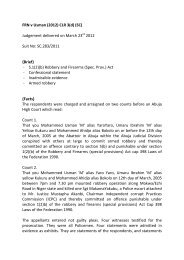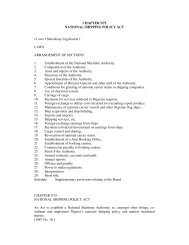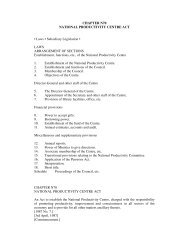Suberu v State.pdf - Aksjlegalresource.com
Suberu v State.pdf - Aksjlegalresource.com
Suberu v State.pdf - Aksjlegalresource.com
Create successful ePaper yourself
Turn your PDF publications into a flip-book with our unique Google optimized e-Paper software.
extra judicial statement made by a co-accused which is governed by Section 27(3) of<br />
the Evidence Act and evidence given by a co-accused on oath which is governed by<br />
Section 178(2) of the Evidence Act.<br />
An extra judicial statement by a co-accused remains a statement and not his evidence. It<br />
is binding on the maker only. See: Ogiri & Anor. v. The Slate (supra) at page 5;<br />
Chukwueke v. The <strong>State</strong> (supra) at page 616 both cited by learned Counsel for the<br />
Appellant.<br />
The above is still not the end in respect of the said Exhibit 1 under fire. The Criminal<br />
Procedure (<strong>State</strong>ment to Police Officers) Rules. 1960 which is applicable to Kogi <strong>State</strong><br />
regulates the manner in which Police Officers are to record extra judicial statements<br />
made by accused persons. Rule 7(1) provides as follows:-<br />
"When a police officer has decided to make the same <strong>com</strong>plaint against two<br />
or more persons and their statements are taken separately, the police officer<br />
shall not read such statement to the other person or persons, but each of such<br />
persons shall be given a copy of such statements and nothing shall be said or<br />
done by the police to invite a reply."<br />
It is not on record that PW3 gave the Appellant opportunity to react to the statement of<br />
the 4th accused - exhibit 1. If the prosecution intended to employ Exhibit 1 against the<br />
Appellant, a copy of same should have been made available to him. Since it was not<br />
made available to him, it ought not to have been used against him. Exhibit 1, in the<br />
prevailing circumstance is not a legally admissible evidence against the Appellant<br />
when considering his case. The case of R. v. Afose & Ors, (supra). Ozaki & Anor. v. The<br />
Slate (supra) and Yongo v. COP (supra) are all in point here.<br />
The Court below held that Exhibit 1 was admissible against the Appellant because it was<br />
relevant. With due respect, relevancy is not the only yardstick or test for admissibility. A<br />
document may be relevant and still be excluded if there is in existence a law, like the<br />
provision of Section 27(3) of the Evidence Act, which renders Exhibit 1 inadmissible as<br />
against the Appellant. It is akin to a deed of conveyance which though relevant in an<br />
action for declaration of title and yet may be excluded because it had not been<br />
registered. This is not a 'spurious correlation'; if I may employ the Economist's<br />
terminology. I am of the considered opinion that the Court below goofed in the stance<br />
taken by it in this respect.<br />
The Court below also held that it was premature for the Appellant to have contended<br />
that Exhibit I could not be used against him at the stage of a No-Case submission. I feel






